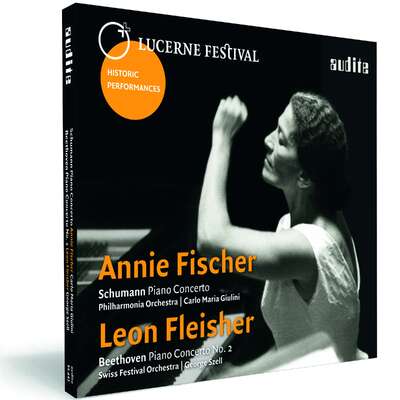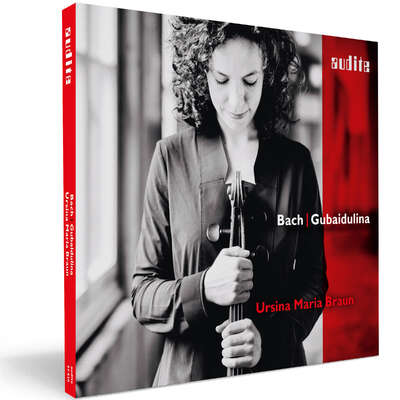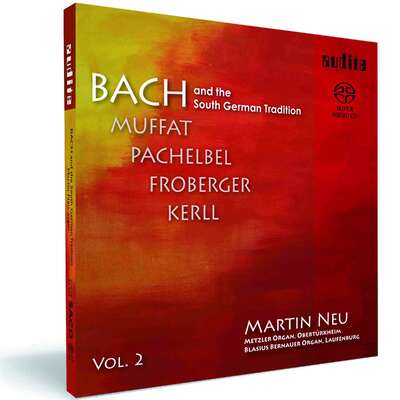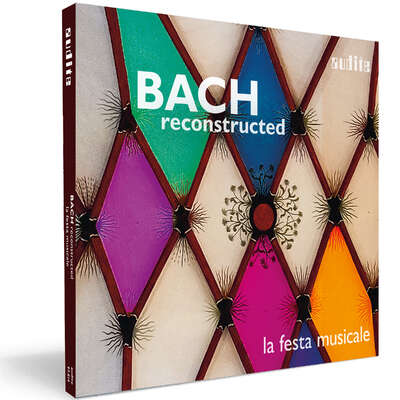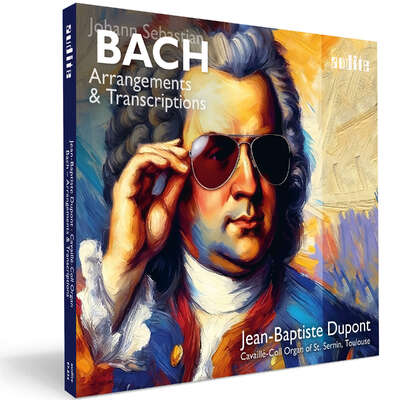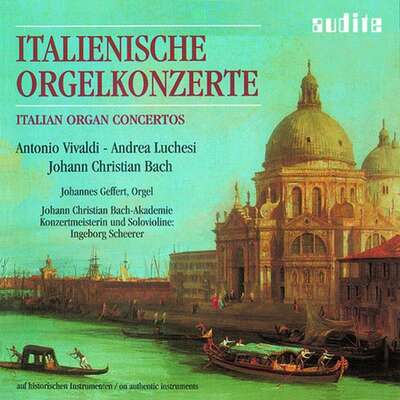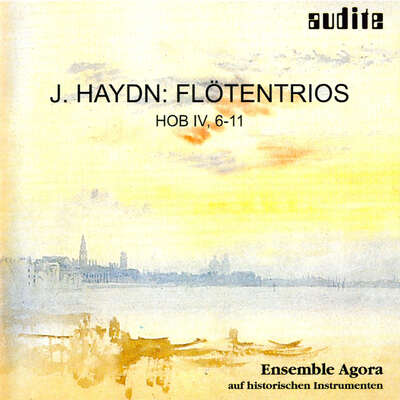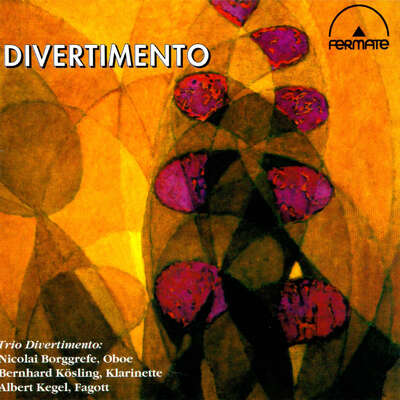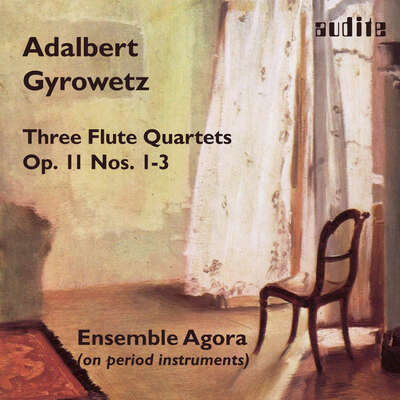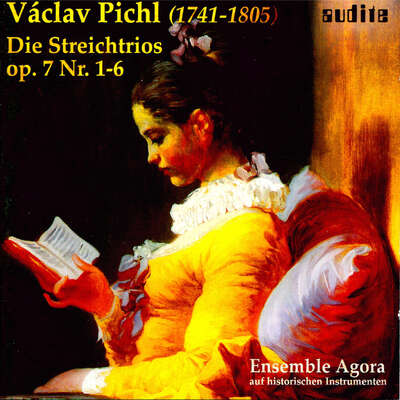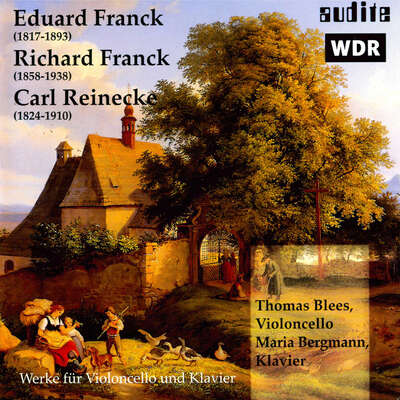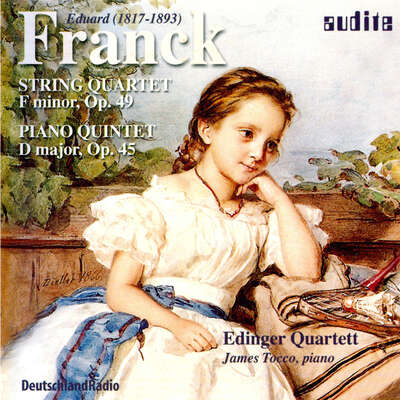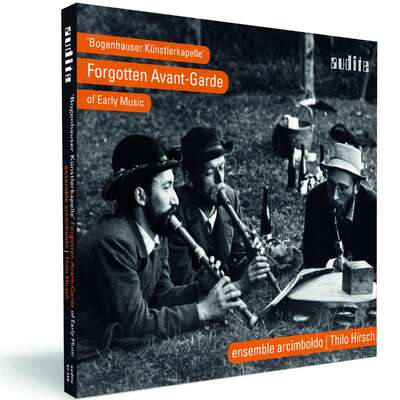
Auto-Rip
Paul Tortelier (1914-1990) zählt zu den Maßstab setzenden und bedeutenden Cellisten seiner Generation. Alle hier präsentierten Einspielungen sind Erstveröffentlichungen. Schumanns Fantasiestücke hat Tortelier zudem nie an anderer Stelle aufgenommen; dies gilt ebenso für die Sonate von Casella und für zwei Sätze seiner eigenen Trois p’tits tours. In den Kammermusik- und Solowerken von Bach bis zur frühen Moderne kommt Torteliers so ausdrucksvolles wie elegantes Spiel beeindruckend zur Geltung.mehr
"[...] this RIAS collection will retain an essential place in this artist’s legacy." (Audiophile Audition)
Titelliste
Details
|
Paul Tortelier: RIAS Recordings
Cello Works by Beethoven, Mendelssohn, Brahms, Bach, Fauré, Paganini, Schumann, Casella, Kodály & T |
|
| Artikelnummer: | 21.455 |
|---|---|
| EAN-Code: | 4022143214553 |
| Preisgruppe: | CL |
| Veröffentlichungsdatum: | 7. Februar 2020 |
| Spielzeit: | 206 min. |
Zusatzmaterial
- Digibooklet Paul Tortelier
-
Producer's comment
unmittelbare Eindrücke des Produzenten Ludger Böckenhoff
- Longlist 2/2020 Preis der Deutschen Schallplattenkritik
Informationen
Paul Tortelier war neben Pierre Fournier der bedeutendste französische Cellist seiner Zeit und weltweit einer der gefragtesten. Seine mehr als 50 Jahre währende Karriere begann er gegen Ende der 1930er Jahre. 1948 besuchte er im Rahmen einer Europa-Tournee Berlin, wo er bis zu seinem Tod 1990 etliche Male konzertierte und parallel dazu beim Rundfunk Aufnahmen einspielte. Seine Studioproduktionen für den Berliner RIAS werden hier nun zum ersten Mal veröffentlicht. Am Klavier begleitet wird er von den damaligen Hauspianisten des RIAS, Klaus Billing und Lothar Broddack.
Paul Tortelier, der in den 1930er und frühen 1940er Jahren sein Auskommen als Solocellist in Orchestern in Paris, Monte Carlo und Boston fand, lernte im Bach-Jahr 1950 Pablo Casals kennen, der ihn zu Auftritten bei seinem neugegründeten Festival in Prades (und 1951 in Perpignan) einlud. Die Musik Johann Sebastian Bachs blieb zeitlebens ein Fix- und Angelpunkt von Paul Torteliers musikalischem Denken. In der vorliegenden Edition lässt sich nachhören, wie er Bachs Cello-Solosuite D-Dur höchst expressiv deutet, ohne dass der musikalische Fluss durch willkürliche Freiheiten unterbrochen wird. Diese Haltung, die das sachliche Bachspiel der Vorkriegszeit mit der ungezügelten Leidenschaft seines Vorbilds Casals verbindet, war zur damaligen Zeit durchaus ungewöhnlich.
Für die aktuelle Veröffentlichung wurden Kammermusikproduktionen aus dem Archiv von Deutschlandfunk Kultur zusammengestellt, die die enorme Bandbreite des Repertoires dieses großen Cellisten eindrucksvoll abbilden und die ihn zugleich auf einem frühen Höhepunkt seiner Karriere zeigen. Drei Werke sind in dieser Edition zum ersten Mal überhaupt in Torteliers Interpretation auf CD zu hören: Robert Schumanns Fantasiestücke op. 73, Alfredo Casellas Cellosonate C-Dur und zwei seiner eigenen Trois p'tits tours, von denen bislang nur das dritte Stück Le Pitre auf Tonträger zu hören war.
Zu dieser Produktion gibt es wieder einen „Producer's Comment" vom Produzenten Ludger Böckenhoff unter https://www.audite.de/media/file/00/35/52/producer-s-comment-aud-21455.pdf.
Besprechungen
Rondo | 2/2024 (April/Mai 2024) | Kai Luehrs-Kaiser | 22. März 2024 Blind gehört – Jan Vogler: „Rostropowitsch greift rein!“
"Das Stück spiele ich nicht. [...] Es ist aber berühmt. Und wird hier von einem sehr guten Cellisten gespielt. [...] 1949, sagen Sie? Dafür klingt die Aufnahme sehr gut. [...] Der stählerne Ton immerhin, den wir hier hören, könnte auf Paul Tortelier hindeuten. [...] Eine ganz tolle Persönlichkeit, muss ich sagen."Mehr lesen
Classica – le meilleur de la musique classique & de la hi-fi | N° 259 - Février 2024 | Michel Le Naour | 1. Februar 2024
L’œuvre en bref
Sonate pour violoncelle seul de Zoltán Kodály
Paul Tortelier, Don Quichotte du violoncelle, brave avec panache les écueils de l’œuvre et soulève des montagnes (EMI, 1979). Auparavant, à la radio de Berlin (RIAS) en 1949, il se montre encore plus ardent (Audite, 2020). Mehr lesen
Classica – le meilleur de la musique classique & de la hi-fi | Numéro 229 - Février 2021 | Thomas Deschamps | 1. Februar 2021
Tortelier ne sonnait jamais de manière lisse au concert; il se montrait impétueux, contradictoire, bouillonnant, à l'image de l'homme engagé qu'il fut. Rien que pour témoigner de cela, ces trois CD doivent être thésaurisés.Mehr lesen
American Record Guide | August 2020 | David W. Moore | 1. August 2020
Paul Tortelier (1914-90) was one of the greatest cellists of his time. This program consists of first releases of recordings he made in 1949, 1962,Mehr lesen
Magcentre | samedi, 6 juin 2020 | 6. Juni 2020 | Quelle: https://www.magc... Le violoncelliste Paul Tortelier chez EMI et AUDITE
Le coup d’archet de l’homme à la pique oblique est magnifique.Mehr lesen
Lion Magazine | Juin 2020 | Claude Lamarque | 1. Juni 2020 | Quelle: https://mydigima...
Ces trois CD représentent des moments extraordinairesMehr lesen
BBC Music Magazine | June 2020 | Michael Church | 1. Juni 2020
Historical
Michael Church listens to live recordings by legendary stars of the last century
Paul Tortelier as a musician and teacher believed that music's vertical and linear dimensions – harmony and counterpoint – should be kept inMehr lesen
Diapason | N° 690 - Mai 2020 | Jean-Michel Molkhou | 1. Mai 2020
Tout feu tout flamme
Puisé dans les archives de la Radio (américaine) de Berlin, un portrait vibrant et fantasque de Paul Tortelier, où Casella, Kodaly et Fauré croisent Brahms, Mendelssohn, Bach, Fauré…
Audite poursuit son exploration des archives de la RIAS – la Radio créée à Berlin Ouest par les troupes américaines d'occupation dès la fin deMehr lesen
Régulièrement invité à Berlin, depuis le triomphe de sa première apparition en 1947 sous la baguette de Sergiu Celibidache, le grand violoncelliste français prit connaissance des studios de la toute récente station berlinoise les 12 et 13 février 1949, lorsqu'il y grava son unique témoignage dans les Fantasiestücke op. 73 de Schumann en compagnie du pianiste Klaus Billing. Une vision intensément lyrique et rythmiquement très libre, qui atteste déjà sa personnalité romanesque, à laquelle la prise de son confère une spectaculaire présence.
Feu d'artifice
Il enregistre, lors de la même session, la prodigieuse sonate de Kodaly (son unique version officielle, pour Emi, ne sera réalisée que trente ans plus tard), sans aucun montage et dans les conditions du concert. Si quelques petits écarts d'intonation sont perceptibles, jamais Tortelier ne perd le fil d'un discours intensément narratif et souvent fantasque, parcourant un paysage harmo-nique complexe. L'évocation des instruments du folklore populaire hongrois, donnant l'illusion d'une polyphonie, produit le feu d'artifice voulu et confirme la prodigieuse maîtrise de l'interprète.
Tortelier glisse également dans le programme une de ses propres compositions. publiée la même année (1949), Trois p‘tits tours, dont c'est ici le seul enregistrement intégral. Et le complète par une vision dense de la Sonate en mi mineur de Brahms, grave el profonde, notamment dans un Allegretto au tempo très retenu. La rare Sonate op. 45 d'Alfredo Casella (1927), captée le 30 janvier 1962 et dont la vive et inventive Bourrée comme l'impulsive Gigue finale méritent la découverte, constitue un autre apport à la discographie de Tortelier.
Les autres documents permettent de retrouver cet artiste attachant dans quelques pages fondamentales du répertoire, accompagné des pianistes « maison » de la Radio berlinoise. Il y démontre tour à tour autorité et pureté de style (Bach, Beethoven), lyrisme exubérant et goût du risque (Mendelssohn), grâce et touchante poésie (Fauré).
Deux pièces de virtuosité, Papillon et la Fantaisie Moἵse, complètent ce formidable ensemble, en mettant en valeur l'éblouissante technique de l'un des plus grands maîtres français du xxe siècle.
Gramophone | May 2020 | Rob Cowan | 1. Mai 2020
What we have here, to quote Rüdiger Albrecht’s comprehensive Prior to the Casella Tortelier gives us an often contemplative, broadly paced accountMehr lesen
The second disc opens with an emphatic account of Bach’s Sixth Solo Suite, set at a lower pitch than Tortelier’s generally more colourful 1982 London recording (Warner), whereas Fauré’s G minor Sonata (always a work that Tortelier excelled in), although memorable, traces a less subtle line than the version he made with Jean Hubeau for Erato, especially in the Andante second movement. The first disc opens with an account of Beethoven’s last cello sonata that’s reflective and assertive by turns, Broddack here on very good form, before Tortelier treats us to a warmly communicative reading of Mendelssohn’s Second Sonata, again with Broddack (Feuermann most readily comes to mind here), before Klaus Billing takes over for an unhurried and well-argued account of Brahms’s First Sonata. The virtuoso aspect of Tortelier’s personality is represented by the Paganini/Silva ‘MosesFantasia’, which is brilliantly played. And the emergent personality throughout this set? A great cellist and a deeply human personality whose performances, comparing one with another, are deeply satisfying and in general very consistent. The transfers, taken from clean original mono tapes, fall pleasingly on the ear.
Audio | 5/2020 | Andreas Fritz | 1. Mai 2020
Er war einer der besten Cellisten des 20. Jahrhunderts: Paul Torteller (1914-1990), der unter anderem auch als Lehrer, Komponist und Dirigent wirkte.Mehr lesen
Gramofon | 2020. 04. 16. | Ildikó Lehotka | 16. April 2020 | Quelle: http://www.gramo... Tortelier és Berlin
A francia csellista játéka élvezetes, rendkívül szenvedélyes, olyan hőfokkal tolmácsolja a műveket, hogy az energia a hallgatót is odaszögezi a lejátszóhoz. Mehr lesen
Audiophile Audition | Apr 13, 2020 | Gary Lemco | 13. April 2020 | Quelle: https://www.auda...
"[...] this RIAS collection will retain an essential place in this artist’s legacy." (Audiophile Audition)Mehr lesen
Der neue Merker
| 09.04.2020 | Alexander Walther | 9. April 2020 | Quelle: https://onlineme...
3-CD-Kollektion mit dem Cellisten Paul Tortelier bei audite erschienen
Meister der Phrasierungskunst
Torteliers Abschied von Berlin fiel in eine Zeit des Mauerfalls. Bei seinemMehr lesen
Stretto – Magazine voor kunst, geschiedenis en muziek | april 3, 2020 | Michel Dutrieue | 3. April 2020 | Quelle: https://www.stre... 3 bijzondere cd’s op het label Audite. Uniek!
Paul Tortelier (1914-1990) was, naast Pierre Fournier, de grootste Franse cellist van zijn tijd en een van de meest gevraagde, internationaleMehr lesen
Paul Tortelier, geboren in Parijs, werd op twaalfjarige leeftijd student aan het Conservatorium van Parijs, waar hij vier jaar later afstudeerde als beste cellostudent. Zijn leraren waren Louis Feuillard, (1872-1941), de auteur van de belangrijke “Exercices journaliers” voor cello en Gérard Hekking, en zijn docent harmonieleer was Jean Gallon (1878-1959). De Nederlands-Franse cellist, (1879-1942) Gérard Hekking was ook de leraar van Pierre Fournier en Maurice Gendron. en Gallon was ook de leraar van o.a. Maurice Duruflé, en Olivier Messiaen. Van 1935 tot 1937 was Tortelier solocellist van het Orchestre Philharmonique de Monte Carlo. Hier speelde hij onder andere de solopartij in Richard Strauss’ Don Quichote. Dit stuk werd later veelal geassocieerd met Tortelier. Hij voerde het vaak uit en maakte er ook opnamen van. In 1939 trad hij toe tot het Boston Symphony Orchestra. In 1947 maakte hij zijn debuut in het Verenigd Koninkrijk, waar hij opnieuw Don Quichote van Richard Strauss speelde. In 1950 werd Tortelier door Pablo Casals geselecteerd om te spelen als eerste cellist in het Prades Festival Orchestra.
Paul Tortelier werd in 1956 professor aan het Conservatorium van Parijs. In 1969 verliet hij als gerenommeerd pedagoog, het Conservatorium voor de Folkwanghochschule in Essen, waar hij bleef tot 1975, en daarna gaf hij nog van 1978 tot 1980, les aan het Conservatorium van Nice. Tortelier gaf les aan o.a. Jacqueline du Pré. In 1955 maakte hij met de toen wereldberoemde, Engelse pianist/begeleider (senior staff accompanist van de BBC), Ernest Lush (1908-1988) zijn televisiedebuut op de BBC. Daarna gaf hij voor de Britse televisie nog een reeks masterclasses die een groot succes waren. Tortelier schreef ook het boek, “How I Play, How I Teach” (“Comment je joue, comment j’enseigne”), uitgegeven door Chester in Londen in 1973.
Tortelier is tweemaal getrouwd. Zijn eerste huwelijk, met Madeleine Gaston, eindigde in 1944 in een scheiding. Daarna huwde hij met de celliste, Maud Monique Martin . (°1951) (foto). Uitzonderlijk is het feit dat hij zijn kinderen terugtrok uit het formele onderwijs om zich enkel aan de muziek te kunnen wijden. Tijdens een interview op de Britse tv werd hem gevraagd of er geen autoriteiten in Frankrijk waren waardoor je kinderen naar school moest sturen. Hij antwoordde: “Ik ben een solist en zij zullen solist zijn.” Zijn zoon, de als violist opgeleide, Yan Pascal Tortelier (°1947), die les kreeg van o.a. Nadia Boulanger, is een internationaal bekend dirigent geworden, zijn dochters, Maria de la Pau (foto’s) is pianiste, en zijn andere dochter, Pomone, is celliste,fluitiste en zangers…
Maria de la Pau (foto’s) werd geboren in 1950 tijdens het eerste festival Pablo Casals in Prado. Casals (foto) werd haar peetvader (foto) en gaf haar de naam Pau (vrede), die zij naast haar familienaam gebruikt. Op vijfjarige leeftijd kreeg zij haar eerste piano- en vioollessen waarna zij definitief voor de piano koos. Zij voltooide haar opleiding aan het conservatorium van Parijs bij Jeanne-Marie Darré en lelia Gousseau, en na haar studie in Parijs volgde ze les bij de pianist en Brahms specialist, Detlef Kraus in Essen.
Lothar Broddack (1930-2019) was als pianist vooral actief in de jaren vijftig. Hij maakte een aantal opnames met celliste Zara Nelsova voor Decca en begeleidde ook de violist, Michael Rabin. Hij was een ervaren pianist die piano doceerde aan de Universität der Künste in Berlijn. De Duitse pianist Klaus Billing werd geboren in Düsseldorf in1910 en overleed in Berlijn in 1991. Hij maakte in de late jaren ’40 en de jaren ’50, naast Hertha klust, naam als begeleider van de jonge Dietrich Fischer-Dieskau.
Rondo | 2/2020 | Guido Fischer | 1. April 2020
Das ist Musik mit ganz großem Herzen gespielt, ohne nur einmal den pathetischen Bogen zu überspannen.Mehr lesen
www.ResMusica.com | 25 mars 2020 | Frédéric Muñoz | 25. März 2020 | Quelle: https://www.resm... Les archives du violoncelliste Paul Tortelier à la radio de Berlin
Plus anciennes que ses enregistrements plus officiels des années 70 pour EMI, ces gravures primitives sont le reflet de l’art d’un jeune et pétulant virtuose. Elles enrichissent le patrimoine discographique lié à cet artiste, dont le jeu évolua beaucoup tout au long de sa carrière.Mehr lesen
www.artalinna.com
| 22 MARCH 2020 | Jean-Charles Hoffelé | 22. März 2020 | Quelle: http://www.artal...
LE DISQUE DU JOUR
Voix Humaine
La discographie de Paul Tortelier aura conservé son art tel quel, rugueux,Mehr lesen
http://operalounge.de
| 11.03.2020 | Dr. Geerd Heinsen | 11. März 2020 | Quelle: http://operaloun...
Ein Großer
Paul Tortelier: Seltene RIAS Recordings bei audite
Bei audite sind selten gehörte Radioaufnahmen aus den Tiefen des Rias-Archives mit dem französischen Cellisten Paul Tortellier erschienen. PaulMehr lesen
Der Kollege Kai Luehrs-Kaiser sagte dazu im rbb kultur radio: Auf drei CDs sind die gesammelten „RIAS Recordings“ des französischen Cellisten Paul Tortelier erschienen – Aufnahmen aus den späten 40er bis mittleren 60er Jahren. Wer ist Paul Tortelier? Paul Tortelier (1914 – 1990) war der wichtigste Cellist der französischen Schule der Nachkriegszeit – neben (dem noch etwas bedeutenderen) Pierre Fournier. Schon 1947 machte Tortelier sich ins noch reichlich kaputte Berlin auf; gewiss auch in Anlehnung an die Bedeutung der Musikstadt in der Vorkriegszeit; wo sowohl Arthur Rubinstein (mit dem er jahrelang ein wichtiges Trio bildete) wie die meisten anderen Musiker seiner Zeit debütiert hatten.
Immer wenn Tortelier in den Folgejahren kam, wurde er sofort vom RIAS für Aufnahmen abgezweigt – meist mit dem erst im letzten Dezember verstorbenen Pianisten (und späteren Berliner Hochschullehrer) Lothar Broddack als Begleiter. Es waren ersichtlich Auftragsarbeiten (von 1949 bis 1964). Mit Bach etwa (kurz bevor er sich mit Pablo Casals anfreundete) fremdelt Tortelier 1949 noch hörbar. Superb dagegen seine ausgewählten Beethoven-, Brahms-, Mendelssohn-, Fauré-, Kodaly- und Casella-Sonaten. (…)
Einige Aufnahmen entstanden sogar noch im alten (Berliner) Kleistsaal. Nicht nur hinsichtlich der französischen Cellistenschule, sondern auch als Berliner Dokument ein höchst schätzenswertes, gewohnt topsolide aufgemachtes audite-Set. Übrigens war Tortelier – als Lehrer von Jacqueline du Pré – 1967 Trauzeuge bei der Hochzeit du Prés mit Daniel Barenboim. Noch ein halbberliner Aspekt also … Noch bis 1989 war er in Berlin zu Gast – teilweise gemeinsam mit seinem in Berlin als Dirigent wirkenden Sohn Yan-Pascal Tortelier (beim damaligen SOB etc.).
www.musicweb-international.com | Monday March 2nd | Jonathan Woolf | 2. März 2020 | Quelle: http://www.music...
Paul Tortelier’s international career began in 1947 in which year he first visited Berlin to perform; the first of two concerts had to be cancelledMehr lesen
The most exciting thing about this tranche of previously unreleased broadcast performances is that Tortelier left no studio inscriptions of three of the works performed – the Casella sonata and, rather surprisingly, the Schumann Fantasiestücke, and his own Trois p'tits tours. Of this last he frequently performed as an encore, and recorded, the brilliant third piece, Le Pitre but he never recorded the remaining two.
That should be inducement enough at least to consider this splendidly realised release but then there are the more-or-less staples of his repertoire to consider as well. The sequence begins in 1949 with Brahms’ Sonata No. 1, the Schumann, the Kodály and his Trois p'tits tours, all in typically fine sound and accompanied by Klaus Billing. The Brahms is eloquently refined though he tightened up the finale in his 1977 EMI recording with his daughter, Maria de la Pau. The Schumann is valuable not merely because of its absence in his commercial discography but also because it’s a lyrical and persuasively sung reading. Tortelier fanciers will know that Le Pitre is a fizzy piece of Gallic wit but the companion pieces are almost as characterful in their different ways, not least the charming Ballerine, a winsome waltz. Whilst he may not have the public profile in the Kodály that János Starker did, Tortelier left behind a particularly memorable recording of it nearly thirty years after this Berlin reading. Superbly coordinated and expressively powerful, it and this Berlin performance offer a less explicitly tensile reading than Starker’s but one that is similarly lucid. Later that same year RIAS recorded him in Bach’s Sixth Cello Suite. Similar in conception to the much later 1982 London cycle, his voicings in the Courante are especially compelling and the close-up recording catches a few fingerboard details and shifts.
The Fauré and Casella sonatas come from January 1962, now with Lothar Broddack. Tortelier taped both Fauré sonatas with Jean Hubeau for Erato in the ‘60s – more recently reissued on Warner Classics CD – though the later Eric Heidsieck recordings for EMI in the very early 1970s will be better known. Both are beautiful but the Hubeau catches a real pair of near equals at work and was taped commercially at around the same time as this Berlin performance. Broddack was a fine artist but hasn’t quite the idiomatic flexibility of Hubeau. I wonder why the cellist never recorded the Casella as he plays it with real flair, extracting its Mediterranean rhythms and colour, its amiable crispness and moving tolling quotient, with great subtlety – his control of dynamics and bowing subtleties just as impressive as his left-hand mobility.
The final broadcast comes from 25 February 1964. Beethoven’s Sonata No. 5 in D Major, Op. 102 No. 2 features a much more funereal slow movement than in his later LP with Heidieck whilst in Mendelssohn’s Sonata No. 2, where the Berlin tempo is mostly faster than his 1978 LP with de la Pau, neither performance sounds unduly rushed nor dawdling in comparison with the other. Tortelier recorded his own orchestrated arrangement of Paganini’s Introduction and Variations on 'Dal tuo stellato soglio' with his wife Maud and the ECO in 1973. The piano-accompanied version in Berlin is the work of cellist Luigi Silva (1903-1961), who had in fact recorded the work for Electrola back in 1938 (it would be good to have Silva’s small corpus of 78s restored; these days he’s far better known as an arranger and teacher than performer and recording artist). Tortelier’s wonderful insouciance never slides into complacency; this is refined but truly communicative virtuosity in action. Fauré’s Papillion is the encore.
The pieces are not grouped by recording date but are scattered throughout as seems appropriate. The sound quality is not so radically different that this presents any concern but maybe some listeners would have preferred a chronological sequencing though I can’t say it worried me at all. The three additions to Tortelier’s discography, on the other hand – especially the Casella – are splendid to have and offer richly rewarding listening, as do all the recitals.
RBB Kulturradio | 26.02.2020 | Kai Luehrs-Kaiser | 26. Februar 2020 | Quelle: https://www.rbb-... BROADCAST
Das ist lange her. Auf drei CDs sind die gesammelten "RIAS Recordings" des französischen Cellisten Paul Tortelier erschienen – Aufnahmen aus denMehr lesen
Paul Tortelier (1914 – 1990) war der wichtigste Cellist der französischen Schule der Nachkriegszeit – neben (dem noch etwas bedeutenderen) Pierre Fournier. Schon 1947 machte Tortelier sich ins noch reichlich kaputte Berlin auf; gewiss auch in Anlehnung an die Bedeutung der Musikstadt in der Vorkriegszeit; wo sowohl Arthur Rubinstein (mit dem er jahrelang ein wichtiges Trio bildete) wie die meisten anderen Musiker seiner Zeit debütiert hatten.
Bereitschaft zur Unverwechselbarkeit
Immer wenn Tortelier in den Folgejahren kam, wurde er sofort vom RIAS für Aufnahmen abgezweigt – meist mit dem erst im letzten Dezember verstorbenen Pianisten (und späteren Berliner Hochschullehrer) Lothar Broddack als Begleiter. Es waren ersichtlich Auftragsarbeiten (von 1949 bis 1964). Mit Bach etwa (kurz bevor er sich mit Pablo Casals anfreundete) fremdelt Tortelier 1949 noch hörbar. Superb dagegen seine ausgewählten Beethoven-, Brahms-, Mendelssohn-, Fauré-, Kodaly- und Casella-Sonaten.
Tortelier selbst erklärte den französischen Stil seines Spiels mit einer "subtilen, nervösen" Bogenhand. Der fragile, elegante und sehr freie Ton wurde also von der Rechten generiert. Die heute vielfach anzutreffende Bewunderung für Tortelier (und für Fournier) rührt wohl daher, dass der auf großen Ton und stilistische Universalität geeichten Gegenwart nichts so fern steht wie Torteliers Spezifik und Bereitschaft zur Unverwechselbarkeit.
Topsolide
Einige Aufnahmen entstanden sogar noch im alten Kleistsaal. Nicht nur hinsichtlich der französischen Cellistenschule, sondern auch als Berliner Dokument ein höchst schätzenswertes, gewohnt topsolide aufgemachtes Audite-Set. Übrigens war Tortelier – als Lehrer von Jacqueline du Pré – 1967 Trauzeuge bei der Hochzeit du Prés mit Daniel Barenboim. Noch ein halbberliner Aspekt also ... Noch bis 1989 war er in Berlin zu Gast – teilweise gemeinsam mit seinem in Berlin als Dirigent wirkenden Sohn Yan-Pascal Tortelier (beim damaligen SOB etc.).
Süddeutsche Zeitung | 17. Februar 2020 | Harald Eggebrecht | 17. Februar 2020 | Quelle: https://www.sued...
Ein Star, zwei Talente
Neue CDs: Beim Cellisten Paul Tortelier weiß man, was man hat - virtuosen Glanz. Von Raphaela Gromes wird man noch viel hören.
Drei hörenswerte CDs mit Aufnahmen aus den Jahren 1949, 1962 und 1964, die er [Tortelier] mit den Pianisten Klaus Billing und Lothar Broddack in Berlin für den Rias machte, künden vom "sprechenden", bei aller Brillanz nie glatten, sehr persönlichen Spiel aus solistischem wie kammermusikalischen Geist dieses einzigartigen Cellisten.Mehr lesen
www.pizzicato.lu | 11/02/2020 | Remy Franck | 11. Februar 2020 | Quelle: https://www.pizz... Eigenwilliger, unnachahmlicher Paul Tortelier
Ein französischer Kritiker schrieb: « Falls Casals Jupiter ist, dann ist Tortelier Apollo ». Paul Tortelier (1914-1990), ein wichtiger Exponent derMehr lesen
Die erste CD beginnt mit Beethovens 5. Cellosonate, die zwischen vitalen Ecksätzen ein über neun Minuten langes, mit viel Affetto gespieltes Adagio enthält. So verspielt Tortelier dann in Mendelssohn Zweiter Sonate sein kann, so rhetorisch-bedeutsam und leidenschaftlich-lyrisch spielt er die Erste Sonate von Brahms.
Bach zählte zu den Komponisten, mit denen sich Tortelier zeitlebens beschäftigte. 1966 gab er eine eigene Edition der Suiten heraus und kommentierte: « Der Musik Leben einzuhauchen ist wichtiger als ihr Respekt zu beweisen. » Das musste auch einmal der österreichische Pianist Jörg Demus erfahren, als er mit Tortelier Bach aufführen sollte. Bei der ersten Probe soll Demus ihm in längeren Ausführungen erklärt haben, wie sehr er mit seinem Spiel falsch liege. Tortelier soll geantwortet haben: « Sehr interessant, aber ich fühle es nicht so! » Ein Kennzeichen von Torteliers Bach-Interpretationen ist neben ihrer Eigenwilligkeit das Tänzerische. Die hier zu hörende 6. Suite ist in dieser Hinsicht exemplarisch.
Tortelier war nie sehr angetan von französischer Musik, aber die zweite CD dieses Sets enthält dennoch die 2. Sonate von Gabriel Fauré, feinfühlig und elegant, vor allem aber auch sehr lebendig musiziert.
Ein kleines Cello-Juwel sind die Rossini-Variationen von Paganini, und wenn danach Schumanns Fantasiestücke erklingen, merkt man unschwer, wie gut sich Tortelier jedem Stil, jeder Färbung anpassen konnte.
Auf der dritten CD interessiert neben Torteliers charmanter Eigenkomposition Trois p’tits Tours die Kodaly-Sonate, die hier leidenschaftlicher und packender gespielt wird als in der späteren, viel erhabeneren und lyrischeren Studioproduktion.
Die klangliche Aufbereitung der alten Tonbänder durch Ludger Böckenhoff ist vorbildlich. Der Klang ist klar und rauschfrei. Am Klang der Klaviere und dem Spiel der Pianisten konnte der Restaurator natürlich nichts ändern. Mit dem allzu trockenen Klavierklang und dem nicht besonders inspirierten Spiel der Pianisten muss der Hörer halt leben. Das sollte aber niemanden davon abhalten, diese allein durch den Cellisten spannenden Interpretationen zu hören.
A French critic wrote: « If Casals is Jupiter, then Tortelier is Apollo ». Paul Tortelier (1914-1990), an important exponent of the Franco-Belgian cello school and, moreover, an uncompromising individualist, is honoured by Audite with three CDs. The recordings were made by RIAS Berlin between 1949 and 1964 and not only take into account his broad repertoire, but also the creative imagination of a musician who was in those years at the zenith of his art.
The first CD begins with Beethoven’s Fifth Cello Sonata, which contains, between vital corner movements, an Adagio that is over nine minutes long and played with great affetto. As playful as Tortelier can be in Mendelssohn’s Second Sonata, as rhetorically significant and passionately lyrical is his playing in Brahms’s First Sonata.
Bach was one of the composers with whom Tortelier was occupied throughout his life. In 1966 he published his own edition of the suites and commented: « To breathe life into music is more important than to prove respect for it ». The Austrian pianist Jörg Demus had to experience this once when he was to perform Bach with Tortelier. At the first rehearsal, Demus is said to have explained to him how wrong he was with his playing. Tortelier is said to have replied: « Very interesting, but I don’t feel it that way! » A characteristic of Tortelier’s Bach interpretations, apart from their individuality, is the dancing. The 6th suite heard here is exemplary in this respect.
Tortelier was never very fond of French music, but the second CD of this set nevertheless contains the 2nd Sonata by Gabriel Fauré in a sensitive, elegant and above all very lively performance.
A small cello jewel are the Rossini Variations by Paganini, and the next piece, Schumann’s Fantasiestücke, show well Tortelier was able to adapt to every style and colouring.
On the third CD, in addition to Tortelier’s charming own composition Trois p’tits Tours, the Kodaly Sonata is of interest, played here with more passion and gripping intensity than in the later, much more sublime and lyrical studio production.
Ludger Böckenhoff’s sound processing of the old tapes is exemplary. The sound is clear and noiseless. Of course, the restorer could not alter the sound of the pianos and the pianists’ playing. The listener has to live with the all too dry piano sound and the not particularly inspired playing of the pianists. But that should not prevent anyone from hearing these exciting interpretations by the cellist alone.

































